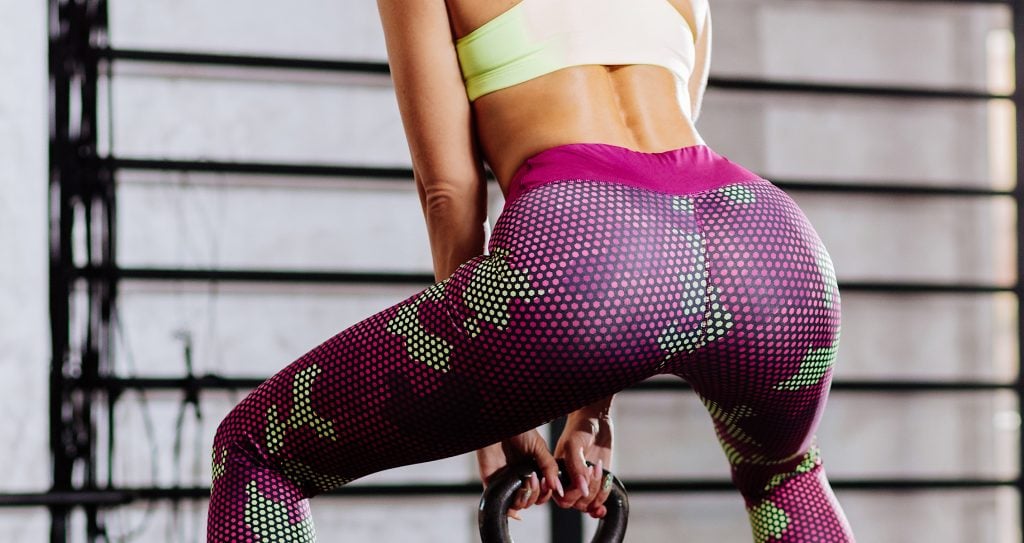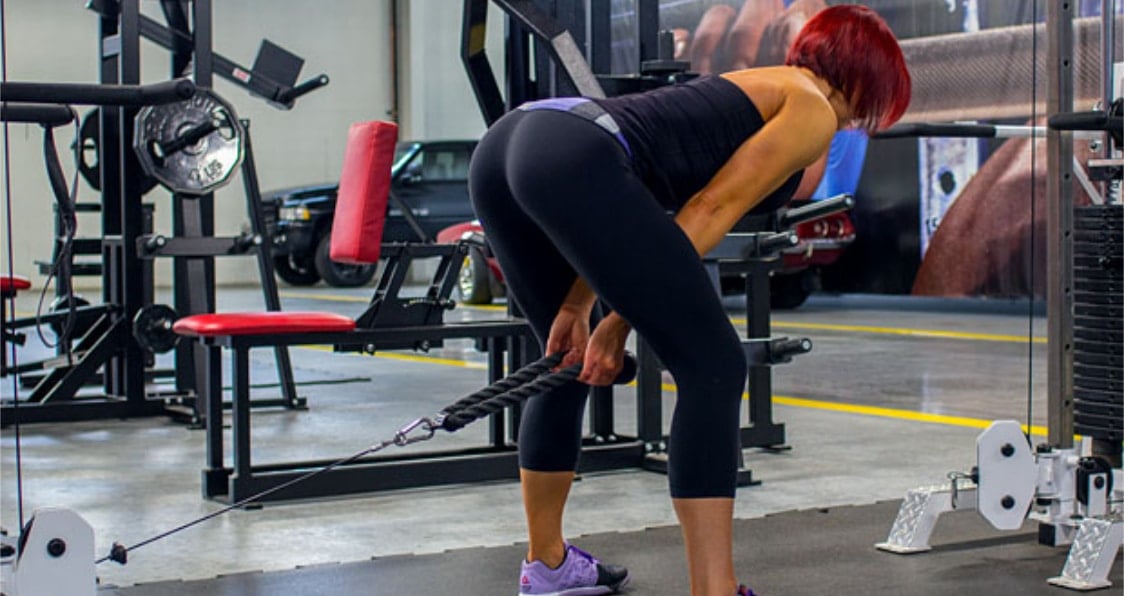Here are alternatives to the barbell hip thrust for building toned, strong glutes.
Enhance your bodybuilding aesthetics with sculpted glutes. Judges at physique and bodybuilding shows recognize the importance of well-developed glutes. In addition, who doesn’t find tone glutes attractive? Let’s examine glute-building exercises like the barbell hip thrust and alternatives like the glute bridge.
However, having strong glutes is more than just aesthetic appeal. They’re also the key drivers of force when doing exercises like deadlifts and squats. Strengthening your glutes can improve your form for these movements, help you avoid injuries, and improve your athletic performance.
The barbell hip thrust is a great exercise for building strength and size in your glutes. It’s a hip extension movement that works on your hamstrings, quads, and hip adductors (1).
Barbell hip thrusts are done with a barbell on your hip and your legs bent while your back is on an elevated surface. But what happens if you don’t have access to barbells or want to mix up your exercise to add fun to your routine while still targeting similar muscles? Below are five effective barbell hip thrust alternatives that the Generation Iron Team has compiled for you to try.
Barbell Hip Thrust Alternatives
1. Dumbbell Step-ups
Dumbbell step-ups are an excellent lower-body strength exercise emphasizing your glutes, hamstrings, and quads. If you don’t have a barbell or the ones at your gym are occupied, try this alternative exercise using dumbbells instead. This study on hip thrusts, deadlifts, step-ups, lunges, and squats found that step-ups are the best for activating your glutes (2).
How to do it:
- Choose a dumbbell weight and stand before a bench or box.
- Put your right foot on the bench or box with your knee at a 90-degree angle with your left leg firmly on the ground. Your shoulders, back, and chest should be out. This is your starting position.
- Pushing through your right leg, raise your body over the platform and lightly touch it with your left leg. Don’t raise the toes of the leg on the platform.
- Push your left hip back to lower your left leg to the ground and complete the rep.
- Switch legs and then repeat steps 1-4.
2. Cable Pull Through
The cable pull through exercise is another barbell hip thrust alternative that targets your glutes and hamstrings. The cable pull through is an isolation exercise that works on erector spinae, iliopsoas, soleus, and adductor magnus. You can also do the banded pull through, a variation of the cable pull through that uses resistance bands.
How to do it:
- Stand facing away from the cable machine and bend your legs to grip the rope using a neutral grip.
- Take one or two steps forward to release the weight. Your feet should be anchored to the ground at shoulder width distance and your torso straight. Keep your arms extended with a slight flex at your elbows and your chin tucked. This is your starting position.
- Tense your shoulder and hips, brace your core, and hinge at your hips until you feel a pull in your legs. Your back should be neutral throughout. At this point, your body will form a 45-degree angle with the floor, and your hands will be behind your knees and between your thighs.
- While keeping your spine neutral, drive your heels into the floor and return to the starting position while squeezing your glutes and pushing your hips forward to complete the rep.
- Repeat for the desired number of reps.
3. Kettlebell Swing
After the cable pull through, we’ll suggest an exercise that uses kettlebells and is considered a full-body routine — the kettlebell swing. Kettlebell swings mainly target the glutes, hamstrings, hip adductors, core, and quads. However, this exercise involves other posterior chain muscles of the back.
How to do it:
- Choose a kettlebell of appropriate weight and then stand with your feet at shoulder width distance apart. Hold the kettlebell in front of you using an overhand grip.
- Engage your core, hinge at your hips, and bend your knees slightly to bring the kettlebell between your legs. Ensure that your back stays straight. This is your starting position.
- Contracting your glutes, push your hips forward to lift yourself back to standing while driving your arms to chest or shoulder height.
- Push your hips backward, bend your knees slightly, and take the kettlebell back between your legs to return to the starting position and complete your rep.
- Repeat for as many reps as you desire.
4. Hyperextensions
Hyperextension is a bodyweight exercise that also targets your glutes, hamstrings, and hip adductors, although you can use free weights. This routine helps to strengthen your posterior chain and can help with some types of lower back pain. To perform hyperextensions, you’ll need a hyperextension machine.
How to do it:
- Start prone with your arms crossed if using your bodyweight or holding a weight plate to your chest.
- Round your upper back and internally rotate your shoulders to keep the tension on your glutes. This is your starting position.
- Descend to a range of motion that stretches your hamstrings well and pause. You’ll feel some tension in your glutes, too.
- Contract your glutes hard, then return to the starting position to complete the rep.
- Repeat for as many reps as possible.
5. Barbell Glute Bridge
Our last alternative, the barbell glute bridge, also uses barbells and helps to build strength and size in your glutes. In fact, this study shows that the barbell glute bridge activates your gluteus maximus more than barbell hip thrusts (3). Both exercises are similar, but you’re on the floor for the glute bridge while you position yourself on a bench for the barbell hip thrust.
How to do it:
- Lie flat on the floor and roll a barbell over your legs to rest where your hips bend.
- Bend your knees at 90 degrees with your feet flat on the ground, and then put your hips on the barbell. This is your starting position.
- Drive your heels into the floor and lift your hips while holding the barbell. Keep your head and shoulders flat on the floor. At this point, your body will form a straight line from your hips to your shoulder.
- Pause for a few seconds and then slowly return to the starting position to complete the rep.
- Repeat for the number of reps that you desire.
Conclusion
The barbell hip thrust is a great exercise for your posterior chain muscles, especially your glutes. These five alternatives also target these muscles and can help you add variety to your workout routine, a great way to prevent a strength plateau. Some of these movements will also help you activate your glutes even better than the barbell hip thrust.
Follow us on Instagram, Facebook, and Twitter for more workouts!
References
- Neto, W. K., Vieira, T. L., & Gama, E. F. (2019). Barbell Hip Thrust, Muscular Activation and Performance: A Systematic Review. Journal of sports science & medicine, 18(2), 198–206.
- Neto, W. K., Soares, E. G., Vieira, T. L., Aguiar, R., Chola, T. A., Sampaio, V. L., & Gama, E. F. (2020). Gluteus Maximus Activation during Common Strength and Hypertrophy Exercises: A Systematic Review. Journal of sports science & medicine, 19(1), 195–203.
- Kennedy, D., Casebolt, J. B., Farren, G. L., Fiaud, V., Bartlett, M., & Strong, L. (2022). Electromyographic differences of the gluteus maximus, gluteus medius, biceps femoris, and vastus lateralis between the barbell hip thrust and barbell glute bridge. Sports biomechanics, 1–15. Advance online publication. https://doi.org/10.1080/14763141.2022.2074875









